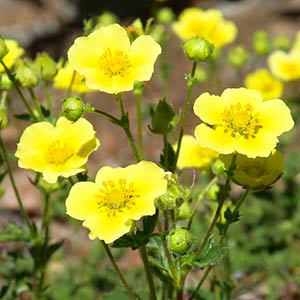Drymocallis pseudorupestris
Drymocallis hansenii
cliff drymocallis, cliff woodbeauty, false rock loving cinquefoil, Rocky Mountain sticky cinquefoil
Hansen's cinquefoil, Hansen's drymocallis or wood beauty, Yosemite woodbeauty
elongate.
short to elongate.
openly tufted to loosely spaced, (0.3–)0.6–4 dm;
base 1–3 mm diam., ± densely septate-glandular.
usually solitary, sometimes loosely tufted, (3–)4–9 dm;
base (1–)2–4 mm diam., moderately to densely septate-glandular.
glabrate or sparsely to ± densely hairy;
basal (2–)3–16 cm, leaflet pairs (2–)3–4(–5);
terminal leaflet broadly obovate-cuneate to flabellate, 0.2–3(–4) × 0.5–3 cm, teeth single or double, 2–15 per side, apex usually rounded to truncate, sometimes obtuse;
cauline 0–2, reduced, leaflet pairs 2–3.
sparsely to moderately hairy;
basal (7–)10–25(–30) cm, leaflet pairs 3–4;
terminal leaflet broadly obovate, 2–5(–6) × 1.5–3.5(–4) cm, teeth single or double, 6–11 per side, apex usually rounded, sometimes obtuse;
cauline 1–3, proximally well developed, leaflet pairs 2–4.
2–40-flowered, not or ± leafy, open, 1/6–3/4(–4/5) of stem, ± wide, branch angles (10–)20–40(–50)°.
10–20(–40)-flowered, not leafy, open, 1/4–2/3 of stem, narrow, branch angles 10–30°.
3–20 (proximal to 40) mm, not or sparsely to moderately short-hairy, predominantly septate-glandular.
2–8 (proximal to 20) mm, predominantly short-hairy, sparsely to moderately septate-glandular.
opening widely;
epicalyx bractlets linear to elliptic, 2–6 × 1–2 mm;
sepals spreading, 4–7(–9) mm, apex acute to obtuse, apiculate;
petals overlapping or not, spreading, cream-white to pale yellow (red-tinged in var. crumiana), narrowly to broadly obovate, 4–12 × 3–11 mm, longer than sepals;
filaments 1–4 mm, anthers 0.7–1.2 mm;
styles thickened, 1–1.5 mm.
opening widely;
epicalyx bractlets linear to narrowly elliptic, 2–4 × 0.5–1 mm;
sepals spreading, 5–8 mm, apex acute to acuminate;
petals overlapping or not, spreading, cream-white to pale yellow, broadly obovate, 4–6 × 3–6 mm, usually longer than, sometimes equal to, sepals;
filaments 1.5–2.5(–3) mm, anthers 0.8–1 mm;
styles thickened, 0.8–1.2 mm.
light brown, 1 mm.
light brown, 0.7–1 mm.
= 14.
Drymocallis pseudorupestris
Drymocallis hansenii
Varieties 3 (3 in the flora).
Drymocallis pseudorupestris occurs from Alberta and Washington to California and Utah, mostly in montane habitats; it is the species most often associated with rocky habitats, including talus slopes, for which its relatively elongate caudex branches are an obvious adaptation. Vestiture is dominated by abundant septate glands on stems and in the inflorescences. Except for var. pseudorupestris, which occurs only in the northeastern part of the species range, plants are relatively short, usually less than 2.5 dm. Three intergrading varieties accommodate the extremes at the northeastern and southern ends of the range.
(Discussion copyrighted by Flora of North America; reprinted with permission.)
D. D. Keck (in J. Clausen et al. 1940) speculated that Drymocallis hansenii was the stabilized recombinant of D. glandulosa var. reflexa and D. lactea. Alternatively, it may represent the California counterpart of D. convallaria, because it tends to have tall, thick-based, single stems and narrow inflorescences. The species is centered in the west-central Sierra Nevada of California, usually occurring in moist meadows and equivalent habitats. Plants near Lake Tahoe, which provide the high-elevation extreme, combine the smaller stature of D. lactea and the glandular-septate stem bases of D. hansenii; their optimal taxonomic disposition is uncertain.
(Discussion copyrighted by Flora of North America; reprinted with permission.)
1. Stems (1–)2–4 dm, bases (1.5–)2–3 mm diam.; basal leaves (4–)7–16 cm; terminal leaflets (1–)2–3(–4) cm, teeth usually double, (5–)8–15 per side; flowers (5–)10–40; petals 6–12 × 5–11 mm, widely overlapping; filaments 2–4 mm. | var. pseudorupestris |
1. Stems (0.3–)0.6–2.5 dm, bases 1–2(–3) mm diam.; basal leaves (2–)3–9(–15) cm; terminal leaflets 0.2–2(–4) cm, teeth single or ± double, 2–8(–12) per side; flowers 2–12(–20); petals 4–8(–9) × 3–6(–8) mm, not or ± overlapping; filaments 1–2.5(–3) mm | → 2 |
2. Basal leaves: leaflet pairs (2–)3(–4); hypanthia and sepals not bristly or bristles less than 1 mm; short hairs sparse to moderately abundant on stems and pedicels (sometimes absent); styles usually golden brown, rarely reddish. | var. saxicola |
2. Basal leaves: leaflet pairs 3–4(–5); hypanthia and sepals prominently bristly, bristles 1–1.5 mm; short hairs absent or sparse on stems and pedicels; styles usually dark red, rarely golden brown. | var. crumiana |
- Local floras:
BC,
CA,
OR
- Local Web sites:
CalFlora,
CalPhotos,
Flora NW,
PNW Herbaria
WildflowerSearch
iNaturalist (observations)
USDA Plants Database
- LBJ Wildflower Center
- SEINet
- Plants of the World Online
- Encyclopedia of Life
- Wikipedia
- Google Image Search


